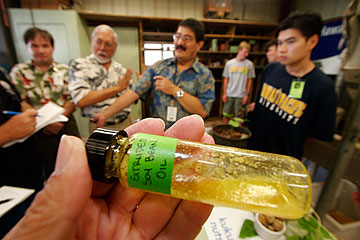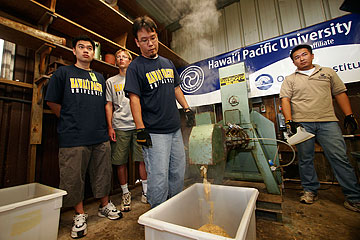
DENNIS ODA / DODA@STARBULLETIN.COM
Researchers Ian Forster, left, Bill Steiner, Warren Dominy and Hendry Sukendy demonstrated yesterday how a machine at the Oceanic Institute pulverizes dried soybeans, producing a mixture from which oil can be extracted. CLICK FOR LARGE
|
|
Agriculture plays role in search for energy
A pilot project will explore potential sources of agricultural biofuel
Local scientists and researchers will test whether avocados make a cleaner burning biodiesel fuel than coconuts. They will also check whether kukui nuts make a better diesel replacement fuel than the jatropha tree from the Caribbean.
The Biodiesel From Fuel Crops in Hawaii Project should have answers to those and other issues a year from now.
The kickoff of the pilot project was held yesterday on the campus of the Oceanic Institute in Waimanalo, at a building that will house a machine that will squeeze the widely different agricultural projects to yield their oil.
The oil will be tested by Pacific Biodiesel. The 11-year-old company is Hawaii's only maker of biofuel. The company is using virtually all of the state's available waste cooking oil to make 1.5 million gallons of biodiesel each year, and is eager to find crops that can be grown locally to produce more biodiesel, President Robert King said.
The main emphasis of the multipartner project is to check out the quality and quantity of biodiesel-grade oil that can be extracted from avocados, coconuts, kukui nuts and the seed of the jatropha tree.
Other partners include the Hawaii Agriculture Research Center; the University of Hawaii-Hilo College of Agriculture, Forestry and Natural Resource Management; and Grace Pacific, which will run emissions tests on the various biodiesels. The nonprofit Honolulu Clean Cities will coordinate.
The U.S. Environmental Protection Agency announced yesterday it is giving the project $100,000.
"This is an awesome project," said Chris Steele, Grace Pacific's environmental manager. "It would make Hawaii less dependent on foreign fuel and keep our crops here." Steele said his company would use biodiesel exclusively if it could get it.
The byproduct of the oil extraction process will be independently studied by the Oceanic Institute for its potential as a component of shrimp or fish feeds. The research and development organization is a leader in aquaculture technologies.

DENNIS ODA / DODA@STARBULLETIN.COM
Researchers Hendry Sukendy, left, Ben Moorman, Gavin Nagaue and Masaya Tanaka used an extruder yesterday to demonstrate the process of extracting oil from soybeans. CLICK FOR LARGE
|
|
At the project announcement yesterday, 500 pounds of soybeans were used to illustrate how an oil extruder will squeeze oil out of the different crops. The technology will have to be experimented with, for instance to deal with kukui nuts' hard shells or to discern whether the pit and fruit of the avocado can be used to make oil, or just the fruit, Robert King said.
Of the four oil-producing crops to be tested, only avocado, at 740,000 pounds' commercial production in 2004, is grown in sufficient quantity for the state to track it.
But that could change once it is known how effective these contenders might be at producing a biofuel, said Kelly King, co-owner of Pacific Biodiesel.
"Every week, people come into my office asking what they can grow," Kelly King said of farmers who are eager to try a biofuel crop.
The four crops getting a look are some of the highest oil-yielding tree crops under consideration for Hawaii biofuel crops, according to a recent study by the Hawaii Agriculture Research Center.
Replacing at least some of Hawaii's diesel use with biofuels will help the state move toward Gov. Linda Lingle's goal of 20 percent renewable energy sources by the year 2020, said Larry Lau, state deputy health director for environmental health.

